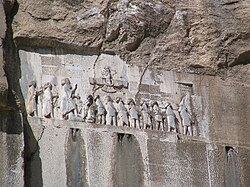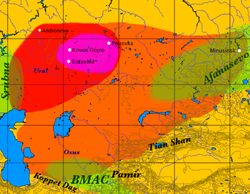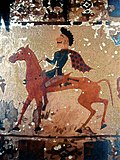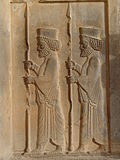Iranic peoples
The Iranic peoples also sometimes called Iranian peoples, are a ethno-linguistic group who speak Iranian languages, a branch of the Indo-European languages.
 Regions where Iranic languages are spoken | |
| Total population | |
|---|---|
| 210-275+ Millions. | |
| Regions with significant populations | |
| File:Flag of Pakistan.svg Pakistan | 19.98% of population[4] |
| File:Flag of Uzbekistan.svg Uzbekistan | 1,544,700[5] |
| 24px Syria | 7%–10% of population[6][7] |
| 24px Iraq | 15–20% of population[8][9] |
| File:Flag of Russia.svg Russia | 760.536[10] |
| File:Flag of Azerbaijan.svg Azerbaijan | 143,300[11] |
| Languages | |
| Iranic languages (a branch of the Indo-European languages) | |
| Religion | |
| Predominately: Islam (Sunni, Shia and Alevi) Minorities: Christianity (Eastern Orthodoxy, Nestorianism, Catholicism and Protestantism), Judaism, Baháʼí Faith, Yazidism, Yarsanism, Zoroastrianism, Assianism (Historically also: Manichaeism and Buddhism) | |
Modern Iranic peoples include: The Gilaks, Balochs, Kurds, Lurs, Mazanderanis, Ossetians, Tats, Talyshs, Pashtuns, Pamiris, Farsis, Nuristani, Wakhis, and Gilaks.
Historical Iranic peoples include the; Alans, Scythians,[12] Dahae, Sakas,[13] Medes, Bactrians, Sogdians,[14] Sarmatians, Parthians, Persians, Khwarezmians,[15] Cimmerians.[16]
Iranic Peoples Media
The Bistun Inscription of Darius the Great describes itself to have been composed in Arya [language or script].
Early Indo-European migrations from the Pontic–Caspian steppe and across Central Asia.
Persepolis: Persian guards
The Eastern Iranic and Balto-Slavic dialect continuums in Eastern Europe, the latter with proposed material cultures correlating to speakers of Balto-Slavic in the Bronze Age (white). Red dots = archaic Slavic hydronyms
References
- ↑ "Iran". The World Factbook. Central Intelligence Agency (United States). "Persian 61%, Azeri 16%, Kurd 10%, Lur 6%, Baloch 2%, Arab 2%, Turkmen and Turkic tribes 2%, other 1%"
- ↑ "Afghanistan". The World Factbook. Central Intelligence Agency (United States). "Pashtun 42%, Tajik 27%, Hazara 9%, Uzbek 9%, Aimak 4%, Turkmen 3%, Baloch 2%, other 4%"
- ↑ "Tajikistan". The World Factbook. Central Intelligence Agency (United States). "Tajik 79.9%, Uzbek 15.3%, Russian 1.1%, Kyrgyz 1.1%, other 2.6% (2000 census)"
- ↑ "Pakistan". The World Factbook. Central Intelligence Agency (United States). "Punjabi 44.68%, Pashtun (Pathan) 15.42%, Sindhi 14.1%, Sariaki 8.38%, Muhajirs 7.57%, Balochi 3.57%, other 6.28% "
- ↑ "Uzbekistan - Tajiks". World Directory of Minorities and Indigenous Peoples. "The Tajiks are an Iranian people who speak a variety of Persian, an Indo-Aryan language. Most of them are Sunni Muslims and according to 2017 government estimates, ethnic Tajiks total 1,544,700 people (4.8 per cent of the population)."
- ↑ "Turkey's Syria offensive explained in four maps". BBC News. "Kurds make up between 7% and 10% of Syria's population. For decades, they were suppressed and denied basic rights by President Bashar al-Assad and, before him, his father Hafez."
- ↑ "Who are the Kurds?". BBC News. "Kurds make up between 7% and 10% of Syria's population. Before the uprising against President Bashar al-Assad began in 2011 most lived in the cities of Damascus and Aleppo, and in three, non-contiguous areas around Kobane, Afrin, and the north-eastern city of Qamishli."
- ↑ "Who are the Kurds?". BBC News. "Kurds make up an estimated 15% to 20% of Iraq's population. They have historically enjoyed more national rights than Kurds living in neighbouring states, but also faced brutal repression."
- ↑ "Iraq". The World Factbook. Central Intelligence Agency (United States). "Arab 75%-80%, Kurdish 15%-20%, Turkoman, Assyrian, or other 5%"
- ↑ Iranian ethnic groups mentioned in the 2010 Russian census:
Ossetian: 528,515
(Digor: 223)
(Iron: 48)
Tajik: 200,303
Kurd: 23,232
(Kurdmandji: 42)
Persian: 3,696
Talysh: 2,529
Tat: 1,585
Pamiri: 363 - ↑ Iranian ethnic groups mentioned in the 2009 Azerbaijani census:
Talysh: 112,000
Tat: 25,200
Kurd: 6,100 - ↑ Ivantchik 2018: "SCYTHIANS, a nomadic people of Iranian origin (...)" Harmatta 1996, p. 181: "[B]oth Cimmerians and Scythians were Iranian peoples." Sulimirski 1985, pp. 149–153: "During the first half of the first millennium B.C., c. 3,000 to 2,500 years ago, the southern part of Eastern Europe was occupied mainly by peoples of Iranian stock [...] [T]he population of ancient Scythia was far from being homogeneous, nor were the Scyths themselves a homogeneous people. The country called after them was ruled by their principal tribe, the "Royal Scyths" (Her. iv. 20), who were of Iranian stock and called themselves "Skolotoi" (...)" West 2002, pp. 437–440: "[T]rue Scyths seems to be those whom [Herodotus] calls Royal Scyths, that is, the group who claimed hegemony [...] apparently warrior-pastoralists. It is generally agreed, from what we know of their names, that these were people of Iranian stock (...)" Rolle 1989, p. 56: "The physical characteristics of the Scythians correspond to their cultural affiliation: their origins place them within the group of Iranian peoples." Rostovtzeff 1922, p. 13: "The Scythian kingdom [...] was succeeded in the Russian steppes by an ascendancy of various Sarmatian tribes — Iranians, like the Scythians themselves." Minns 2011, p. 36: "The general view is that both agricultural and nomad Scythians were Iranian." Diakonoff 1985, p. 48: "The majority of the “Eastern” Iranian tribes – Scythians, Alani, Massagetae, Sakas, Chorasmians, Sogdians – remained on the territory of south-eastern Europe and in Central Asia."
- ↑ Diakonoff 1985, p. 48: "The majority of the “Eastern” Iranian tribes – Scythians, Alani, Massagetae, Sakas, Chorasmians, Sogdians – remained on the territory of south-eastern Europe and in Central Asia."
- ↑ Diakonoff 1985, p. 48: "The majority of the “Eastern” Iranian tribes – Scythians, Alani, Massagetae, Sakas, Chorasmians, Sogdians – remained on the territory of south-eastern Europe and in Central Asia."
- ↑ Diakonoff 1985, p. 48: "The majority of the “Eastern” Iranian tribes – Scythians, Alani, Massagetae, Sakas, Chorasmians, Sogdians – remained on the territory of south-eastern Europe and in Central Asia."
- ↑ Tokhtas’ev 1991, p. 563–567: "CIMMERIANS, a nomadic people, most likely of Iranian origin (...)" Harmatta 1996a, p. 181: "[B]oth Cimmerians and Scythians were Iranian peoples."
- BORJIAN, Habib. "NORTH IRANIC PEOPLES IN THE ENCYCLOPÆDIA IRANICA." NARTAMONGæ (2019): 413.
- "How Did the Scythians Influence the Achaemenid Empire?". DailyHistory.org.
- Gregoratti, Leonardo. "The kings of Parthia and Persia: some considerations on the ‘Iranic’ Identity in the Parthian Empire." Dabir 1.1 (2015): 14-16.
- Toops, Stanley. "The Population Landscape of Xinjiang/East Turkestan." Inner Asia 2.2 (2000): 155-170.
- Gnoli, Gh. "Iranic Identity as a historical problem: the beginnings of a national awareness under the Achaemenians." The East and the Meaning of History (1992): 147-167.
- Lambton, Ann KS. "Persia." Journal of the Royal Central Asian Society 31.1 (1944): 8-22.
- Lohrasp, G. "Some remarks on Farabi's background: Iranic (Soghdian/Persian) or (Altaic)?." (2009).
- صدرا, علیرضا. "Making Discourse and Realization, Monitoring of Islamic–Iranic Progress' Olgou (executive necessaries of Olgou and Political Plans)." سیاست متعالیه 10.38 (2022).
- Waghmar, Burzine. "Settled rather than saddled Scythians: the easternmost Sakas." (2020): 639-649.
- Gregoratti, Leonardo. "The journey east of the Great King: East and West in the Parthian kingdom." The Journey East of the Great King: East and West in the Parthian kingdom (2013): 43-52.
- Khudaverdyan, A. Yu. "A bioarchaeological analysis of the population of the Armenian Highland and Transcaucasus in the Antiquity." The Mankind Quarterly 53.1 (2012): 3-35.
- Foltz, Richard. The Ossetes: Modern-day Scythians of the Caucasus. Bloomsbury Publishing, 2021.
- Watson, William. "The Chinese contribution to eastern nomad culture in the pre‐Han and early Han periods." World Archaeology 4.2 (1972): 139-149.
- Kümmel, Martin Joachim. "“Prothetic h-” in Khotanese and the reconstruction of Proto-Iranic." Script and Reconstruction in Linguistic History.
- Sharkey, Benjamin. "Predators and Prey: Cosmological Perspectivism in Scythian Animal Style Art." Arts. Vol. 11. No. 6. MDPI, 2022.
- Turchin, Peter. "A theory for formation of large empires." Journal of Global History 4.2 (2009): 191-217.
- Farrokh, Kaveh. "Lion and Sun Emblem of Iran, a Pictorial Historical Analysis Historical Analysis in 3 Parts Part 3: Qajars and After."
- Bekhrad, Joobin. "Kiss my lips: Female poets in the Persian language." TLS. Times Literary Supplement 6099 (2020): 28-29.
- Sharif, Nemat. "A Brief History of Kurds and Kurdistan: Part I: From the Advent of Islam to AD 1750." The International Journal of Kurdish Studies 10.1/2 (1996): 105.
- Lee, Joo-yup. "The Sogdian Descendants in Mongol and post-Mongol Central Asia: The Tajiks and Sarts." Acta Via Serica 5.1 (2020): 187-198.
- Ethington, Michael David. "The Hunnic Dilemma: Between Identity and Environmental-Economic Crises." Journal of Asian Civilizations 44.2 (2021): 109-120.
- Turchin, Peter, Thomas E. Currie, and Edward AL Turner. "Mapping the spread of mounted warfare." Cliodynamics 7.2 (2016).
- Waghmar, Burzine. "Settled rather than saddled Scythians: the easternmost Sakas." (2020): 639-649.
- Scarborough, Matthew JC. "Bactrian χϸονο ‘(calendar) year,(regnal) year’." Journal of the Royal Asiatic Society 31.3 (2021): 599-607.
- BORJIAN, Habib. "NORTH IRANIC PEOPLES IN THE ENCYCLOPÆDIA IRANICA." NARTAMONGæ (2019): 413.
- Grønbech, Kaare. "The steppe region in world history. II." Acta Orientalia 24 (1959): 14-14.
- Salvatori, Sandro. "Bactria and Margiana seals: a new assessment of their chronological position and a typological survey." East and West 50.1/4 (2000): 97-145.
- Häberl, Charles. "Balaybalan." (2015).
- Mengal, Mir Aqil Khan. "" THE BARKI TRIBE AND LANGUAGE." Mut̤ālaʻah-yi Pākistān 2 (1991): 83.
- Ethington, Michael David. "The Hunnic Dilemma: Between Identity and Environmental-Economic Crises." Journal of Asian Civilizations 44.2 (2021): 109-120.
- Kovalevskaia, V. B "Central Ciscaucasia in Antiquity and Early Middle Ages: Caucasian Substratum and Migrations of the Iranic-Speaking Tribes." (1988).
Further reading
- Balanovsky, Oleg, et al. "Deep phylogenetic analysis of haplogroup G1 provides estimates of SNP and STR mutation rates on the human Y-chromosome and reveals migrations of Iranic speakers." PLoS One 10.4 (2015): e0122968.







